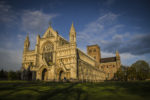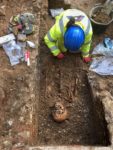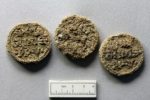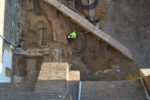 Our friends at the Canterbury Archaeological Trust (CAT) aren’t just busy inventorying their recovered artifacts. They’ve got excavations to do and archaeological treasures to unearth. One of their recent projects is a dig at the Cathedral and Abbey Church of St Albans which just came to a close last month. The excavation began in August 2017 in advance of the construction of a new Welcome Center for the church and focused on a burial ground known as Monks’ Cemetery which was in use from the 18th through the mid-19th century. They recovered 120 inhumed bodies from that cemetery, out of the more the 170 recorded burials before the cemetery’s closure in 1852.
Our friends at the Canterbury Archaeological Trust (CAT) aren’t just busy inventorying their recovered artifacts. They’ve got excavations to do and archaeological treasures to unearth. One of their recent projects is a dig at the Cathedral and Abbey Church of St Albans which just came to a close last month. The excavation began in August 2017 in advance of the construction of a new Welcome Center for the church and focused on a burial ground known as Monks’ Cemetery which was in use from the 18th through the mid-19th century. They recovered 120 inhumed bodies from that cemetery, out of the more the 170 recorded burials before the cemetery’s closure in 1852.
But that’s far from all they unearthed. Not surprisingly, the burial ground lived several previous lives. Under the more recent graves, the archaeological team discovered the remains of a rectangular 15th century building. Two stories high, the building was an addition to the cathedral and is believed to have contained the treasury, sacristy, vestry and two chapels, all accessible from the main building’s transept and presbytery. It was likely razed during the Dissolution of the Monasteries.
 It’s possible, albeit not confirmed, that the abbot’s quarters were also in the 15th century structure. It is confirmed that one abbot in particular was buried under the larger of the two chapels. The excavation unearthed a brick-lined grave containing the body of an adult man. Interred with him with three Papal bullae, lead seals that were attached to official papal decrees known as bulls. While only the obverse of the seals is even partially legible, experts were able to make out the name “Martinus,” which dates the bullae to the papacy of Martin V who occupied the Throne of Peter from 1417 to 1431.
It’s possible, albeit not confirmed, that the abbot’s quarters were also in the 15th century structure. It is confirmed that one abbot in particular was buried under the larger of the two chapels. The excavation unearthed a brick-lined grave containing the body of an adult man. Interred with him with three Papal bullae, lead seals that were attached to official papal decrees known as bulls. While only the obverse of the seals is even partially legible, experts were able to make out the name “Martinus,” which dates the bullae to the papacy of Martin V who occupied the Throne of Peter from 1417 to 1431.
 It’s extremely rare to find a grave that contains more than one of these seals. According to Professor Martin Biddle who is working with the CAT team, the discovery of three is in fact “a unique discovery in archaeology.” This strongly indicates the deceased was someone of great importance in the Church. The dates and further archival research point to this having been John of Wheathampstead. John was the Abbot of St. Albans from 1420-1440, and again from 1451 until his death in 1465. He personally undertook the arduous journey to Rome in 1423 and was granted an audience with Pope Martin V. The abbot asked the pontiff for three privileges and Martin granted all three of them. The deal was sealed with, well, seals, two of them dated November 19th, 1423, and the third November 24th, 1423. Abbot John returned with them to the St. Albans where he was celebrated for his successful mission.
It’s extremely rare to find a grave that contains more than one of these seals. According to Professor Martin Biddle who is working with the CAT team, the discovery of three is in fact “a unique discovery in archaeology.” This strongly indicates the deceased was someone of great importance in the Church. The dates and further archival research point to this having been John of Wheathampstead. John was the Abbot of St. Albans from 1420-1440, and again from 1451 until his death in 1465. He personally undertook the arduous journey to Rome in 1423 and was granted an audience with Pope Martin V. The abbot asked the pontiff for three privileges and Martin granted all three of them. The deal was sealed with, well, seals, two of them dated November 19th, 1423, and the third November 24th, 1423. Abbot John returned with them to the St. Albans where he was celebrated for his successful mission.
The Dean of St Albans, the Very Rev’d Dr Jeffrey John, said, “It is a wonderful thing to have found the grave and relics of John of Wheathampstead, one of the most interesting and successful of the Abbots of St Albans. The papal seals that were found in his grave are a reminder of some of the privileges that he won for his monastery, and of his own national and international influence on the Church at a time when (not unlike today) it was faced with threats of division and decline”.
He continued, “Abbot John added a great deal to the renown and the beauty of the Abbey, and attracted many new pilgrims from Britain and overseas. He also defended the Abbey from destruction during the Wars of the Roses and was proud to say that he had preserved its treasures for future generations. It seems appropriate that he should appear just as we are trying to do the same through the ‘Alban, Britain’s First Saint‘ project, which aims to make the Abbey much better known, and to provide better resources to welcome and inform new visitors. As John would certainly wish, in due course his body will be laid to rest again, with proper prayer and ceremony. We trust he prays for us, as we do for him.”
But it’s not abbots all the way down. Beneath the foundations of the 15th century building the CAT team found the foundations of Norman chapels that were in the apse of the original St. Albans Cathedral built just over a decade after the Norman conquest of England. Paul of Caen, a very well-connected Benedictine monk, became abbot in 1077 and immediately initiated an ambitious building project, replacing the 8th century Anglo-Saxon church with a new one in Norman style. He used materials pilfered by previous abbots from the ruins of the Roman town of Verulamium, just across the river Ver from the abbey, to create a large cruciform structure that was at that time the largest abbey in England. Some of his arches still stand in the nave, as does the tower built at the intersection of the four arms of the crucifix shape (known as a crossing tower). It is the only 11th century crossing tower still extant in England.
 Paul of Caen’s particular attention to building massive foundations is a large part of the reason the tower and arches are still standing to this day, so it’s fitting that even though later construction tore up the walls of the Norman apsidal chapels, the foundations were down there just waiting for archaeologists to find them.
Paul of Caen’s particular attention to building massive foundations is a large part of the reason the tower and arches are still standing to this day, so it’s fitting that even though later construction tore up the walls of the Norman apsidal chapels, the foundations were down there just waiting for archaeologists to find them.
St Albans Abbey has been confirmed as one of England’s early Norman cathedrals after experts uncovered foundations of the early church. […]
The abbey is known as the oldest place of continuous Christian worship in the country and this find pre-dates that.
The site director said: “We knew it was probably there but this confirms it.” […]
“[Our find shows] that it was and is an important site of premier status,” site director Ross Lane said.
“One of our major aims was to confirm its presence and confirm the abbey was one of the early Norman cathedrals.”
I lived in St Albans in the early 1970s and loved everything about the cathedral and town. Alas there were no excavations back then.
The excavation that unearthed a brick-lined grave must have found a very important person. Those three Papal bulls, that date back to the papacy of Martin V (1417-31), were not associated with ordinary people.
The seal actually says ‘Martinus PP V’, not just ‘Martinus’ so there is no doubt it was made by Martin V. JC.
“Having followed the council to Siena, he went thence to Rome, where he fell dangerously ill. On his recovery he obtained some privileges for his abbey from Martin V, again went to Siena, and soon returned thence to England, reaching St. Albans on 25 Feb. 1424.”
Indeed, Martin V was in 1423 hardly inaugurated, when he convened the council at Siena, to which our abbot seemingly attended. Therefore, may I humbly ask what those three “deals” or “privileges” where about?
————
PS: Apart from that, I find it a rather cute idea to imagine standing either in front of ‘Heavens Gate’ -or lying at ‘Judgment Day’ in an open coffin- proudly presenting altogether THREE(!) papal privileges. :yes: Yessir, you heard me right, three of them, and with a ‘Bulla’ for every single one! :p
Here’s a St Albans joke. They refer to the nearby town of Stevenage as St Evenage.